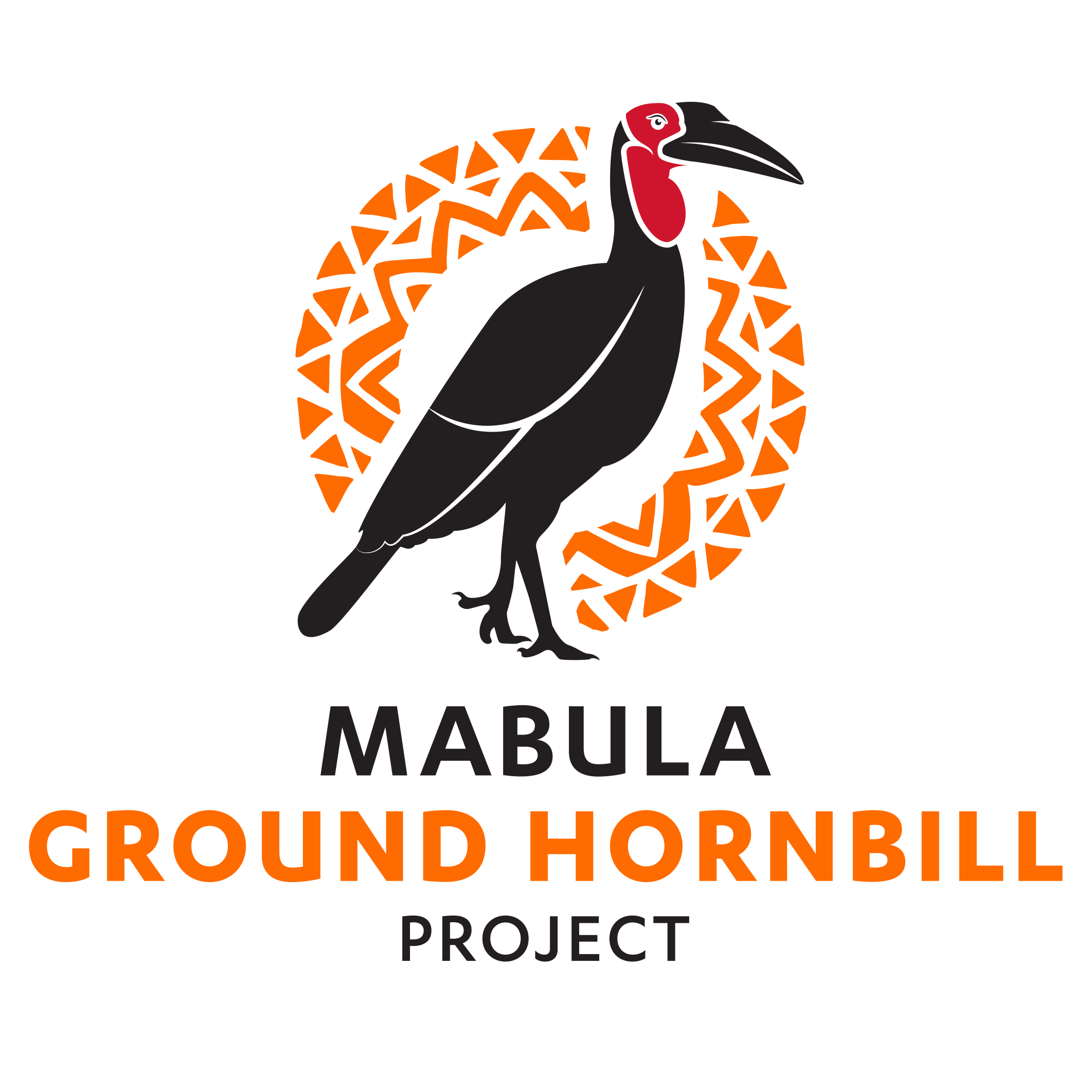THE THUNDER BIRD
MABULA GROUND HORNBILL PROJECT
NEWSLETTER
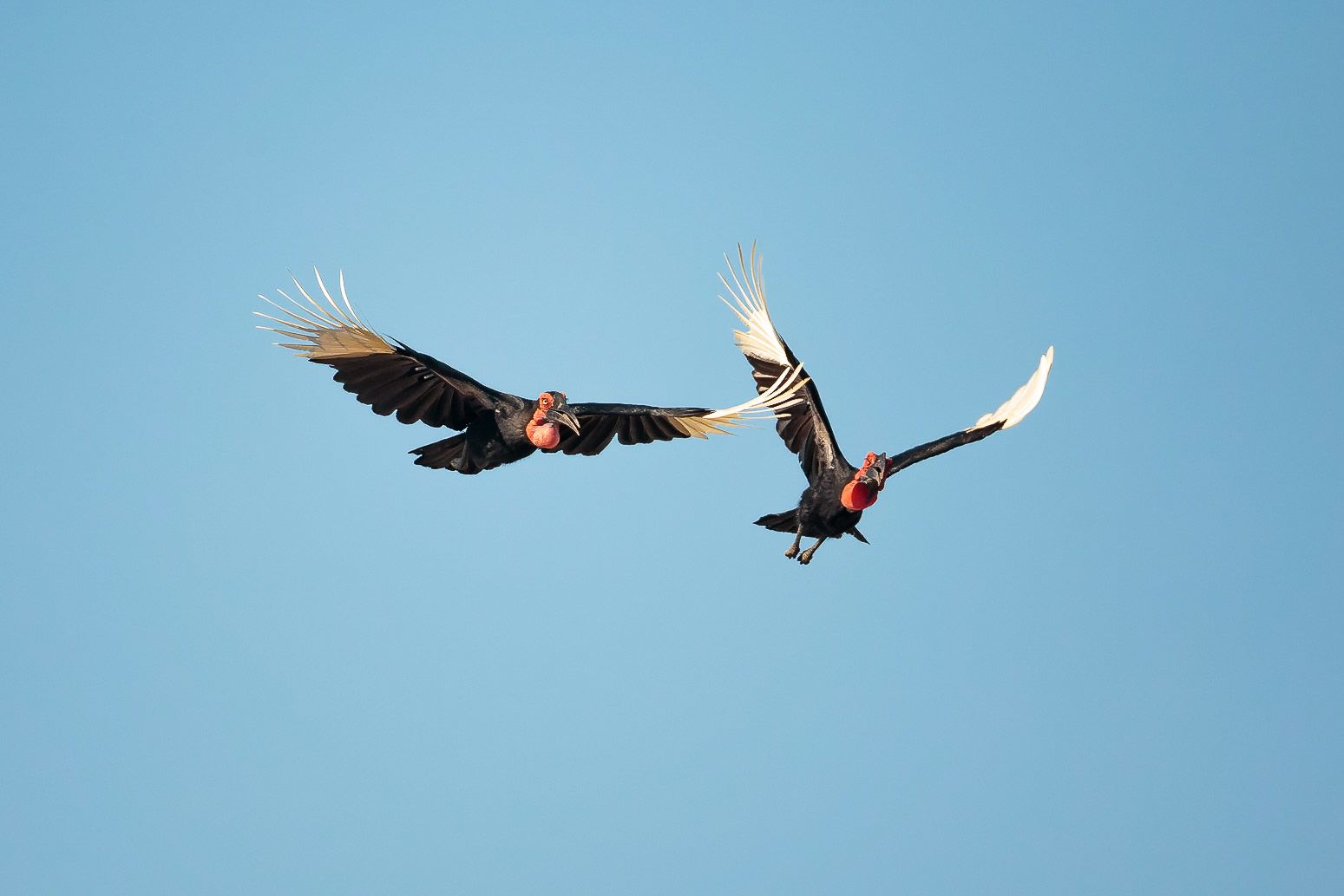
Grant Assistance and BMP Progress

The project is supported by IUCN Save Our Species, co-funded by the European Union.
We are delighted to announce that we have been granted emergency funding by the IUCN Save Our Species, co-funded by the European Union, through their African Wildlife Initiative. The IUCN Save Our Species aims to improve the long-term survival prospects of threatened species, by focusing on supporting the species habitats and working with the communities who share this habitat. It achieves success by funding and coordinating conservation projects into multiple initiatives across the globe. The African Wildlife initiative is a partnership between the European Union and IUCN that responds to conservation challenges facing key threatened species in sub-Saharan Africa. It delivers tangible results for species, habitats and people
This Rapid Action Grant is awarded to projects responding to emergency situations. We’ve done our best to stay on track with our targets, but the COVID pandemic has caused us some delays and difficulties. This assistance couldn’t come at a better time. With this support, we will ensure that none of the conservation priorities in the Biodiversity Management Plan fall behind due to the pandemic crisis. Time is of the essence for endangered species, and we are grateful for this much-needed sponsorship.
Because of the funding provided by this grant, Dr Lucy Kemp has been able to edit and present the Biodiversity Management Plan to the Department of Forestry, Fisheries, and the Environment.
On April 21, the BMP was unanimously approved for gazetting, for distribution and public participation.
This is great news and a big step forward in getting widespread collaboration and protection for the Southern ground-hornbill.
REINTRODUCTION REPORT
Another two groups in the region!

We are very happy to report a successful release of two groups of three ground-hornbills into a new site, in July of 2021 and then in February of this year. With the assistance of the reserve's ecology team, we got our temporary aviary set up, and brought in the pair-bonded groups shortly after, and monitored them for several weeks while they settled in. After a smooth four weeks acclimating, they were released onto the reserve. Everything went according to plan in both cases. The reserve staff is invested in their success, and we plan to keep a close eye on them going forward.
The July group settles in
They quickly learned to follow the rhino for easy meals of bugs in the dung
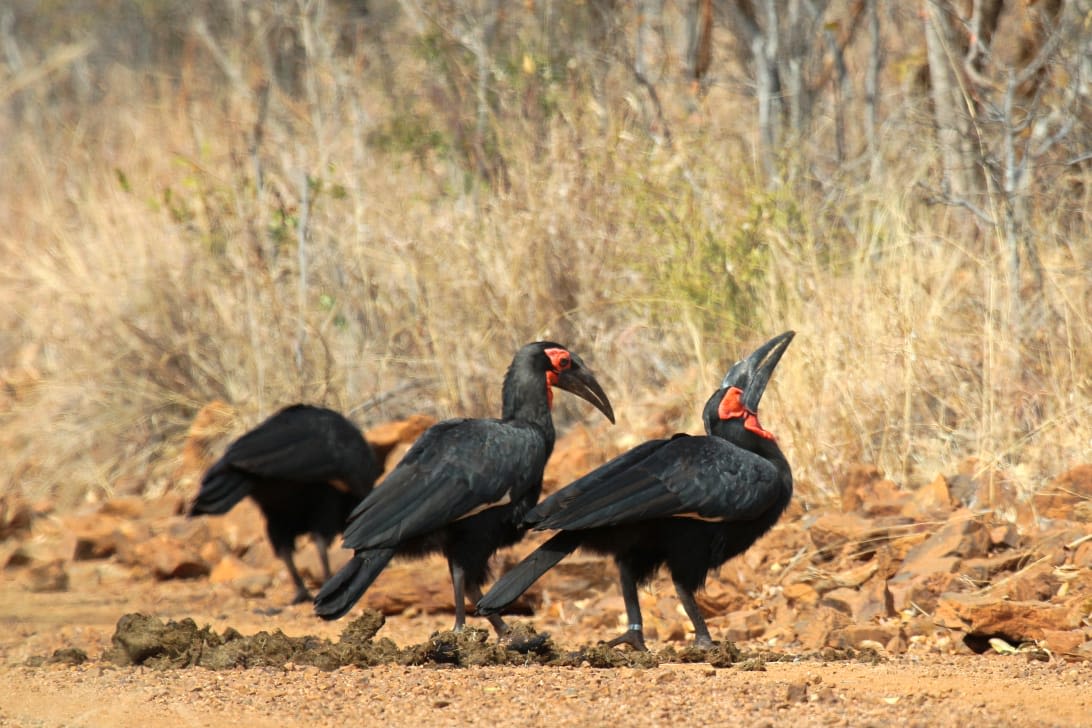
As this group is located here in the Waterberg foothills, they are part of our strategic core of Mabula-Marakele breeding groups, with a goal of establishing a minimum of ten breeding groups in total as a viable, self-sustaining population here in Limpopo. The next focal core will be resolving the growing geneflow gap in northern Zululand.
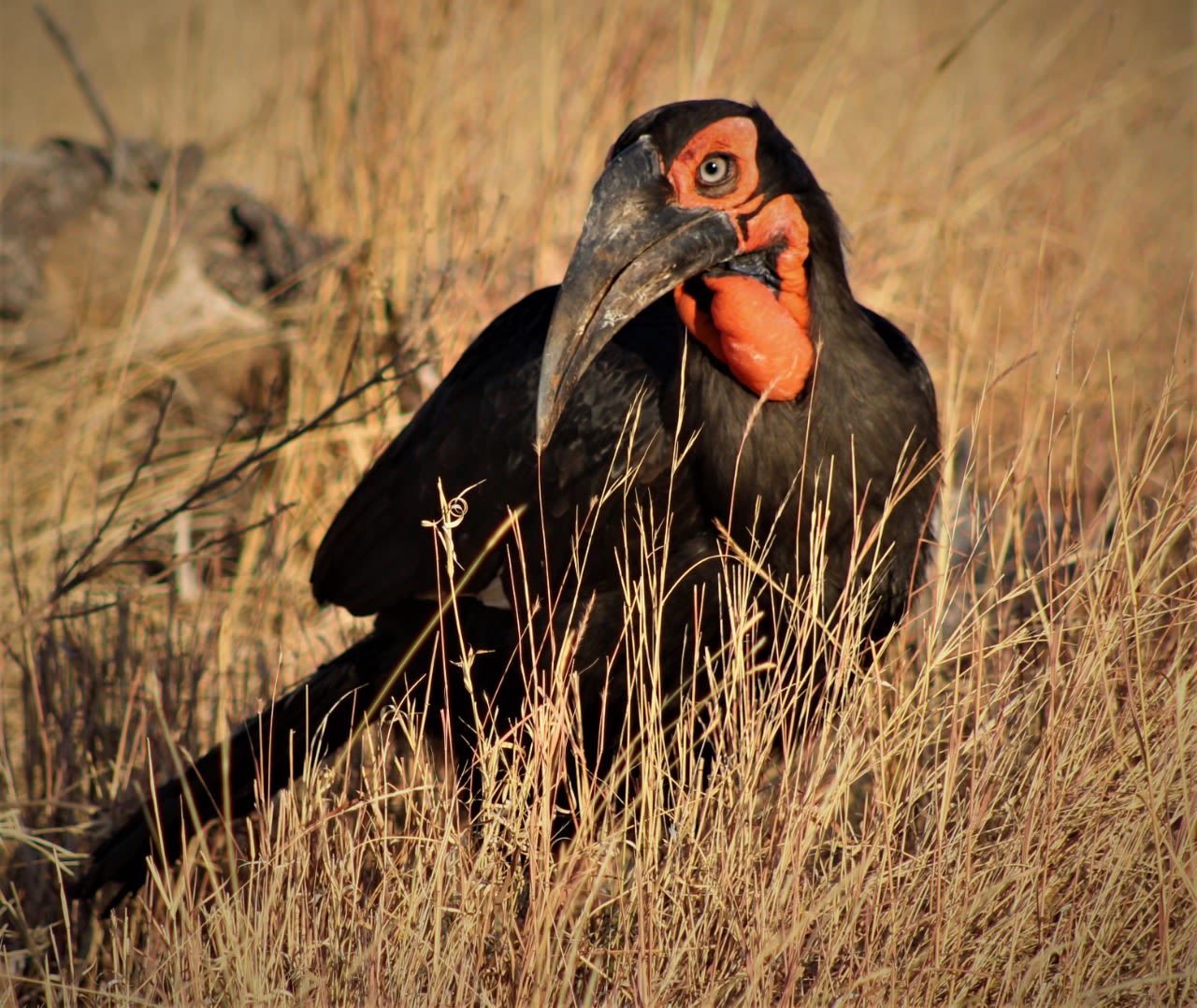
This adult female was once one of the redundant second chicks that we rescued from a wild nest and now she is ready to take on the role of a breeding female in a reintroduced wild group.
This adult female was once one of the redundant second chicks that we rescued from a wild nest and now she is ready to take on the role of a breeding female in a reintroduced wild group.
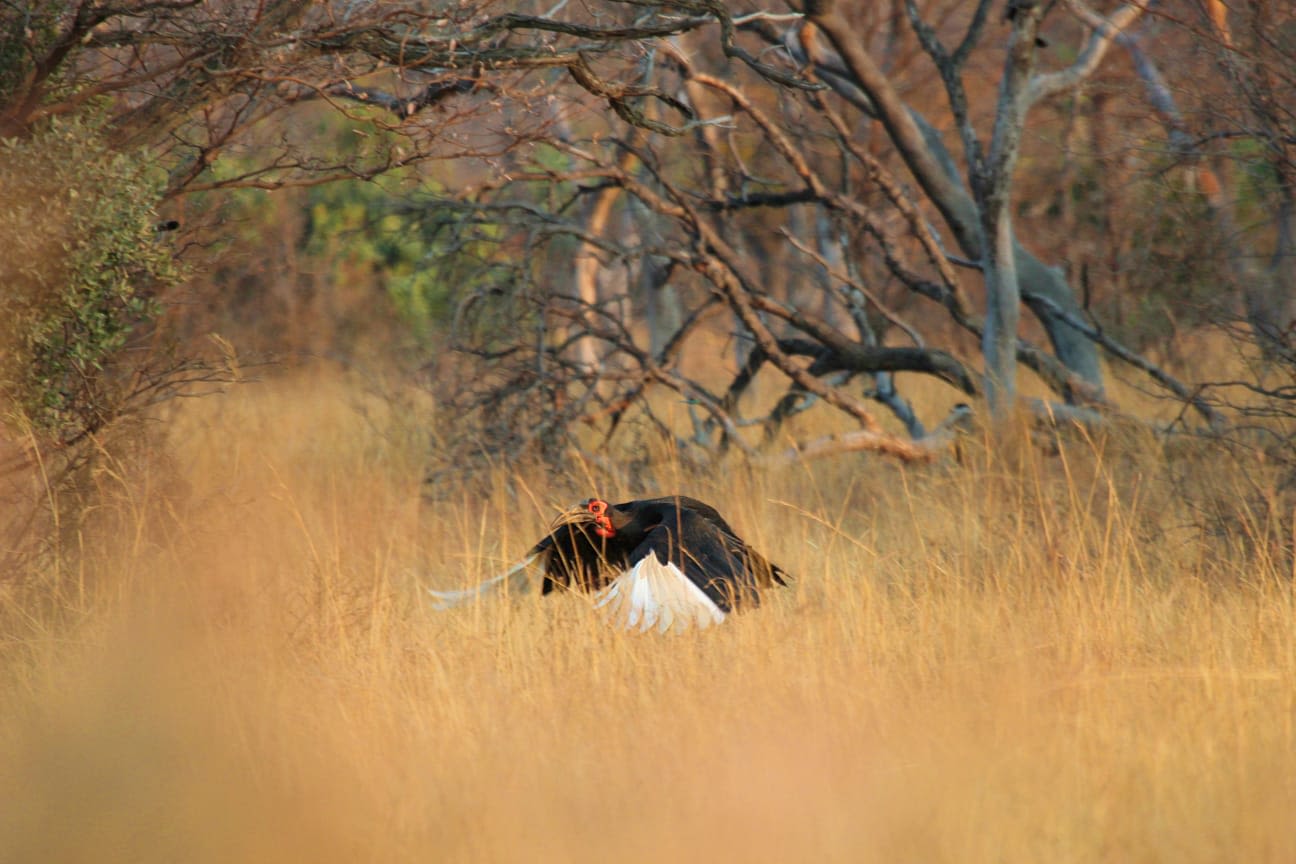
Getting the flight thing right :)
Getting the flight thing right :)
Nest production begins again
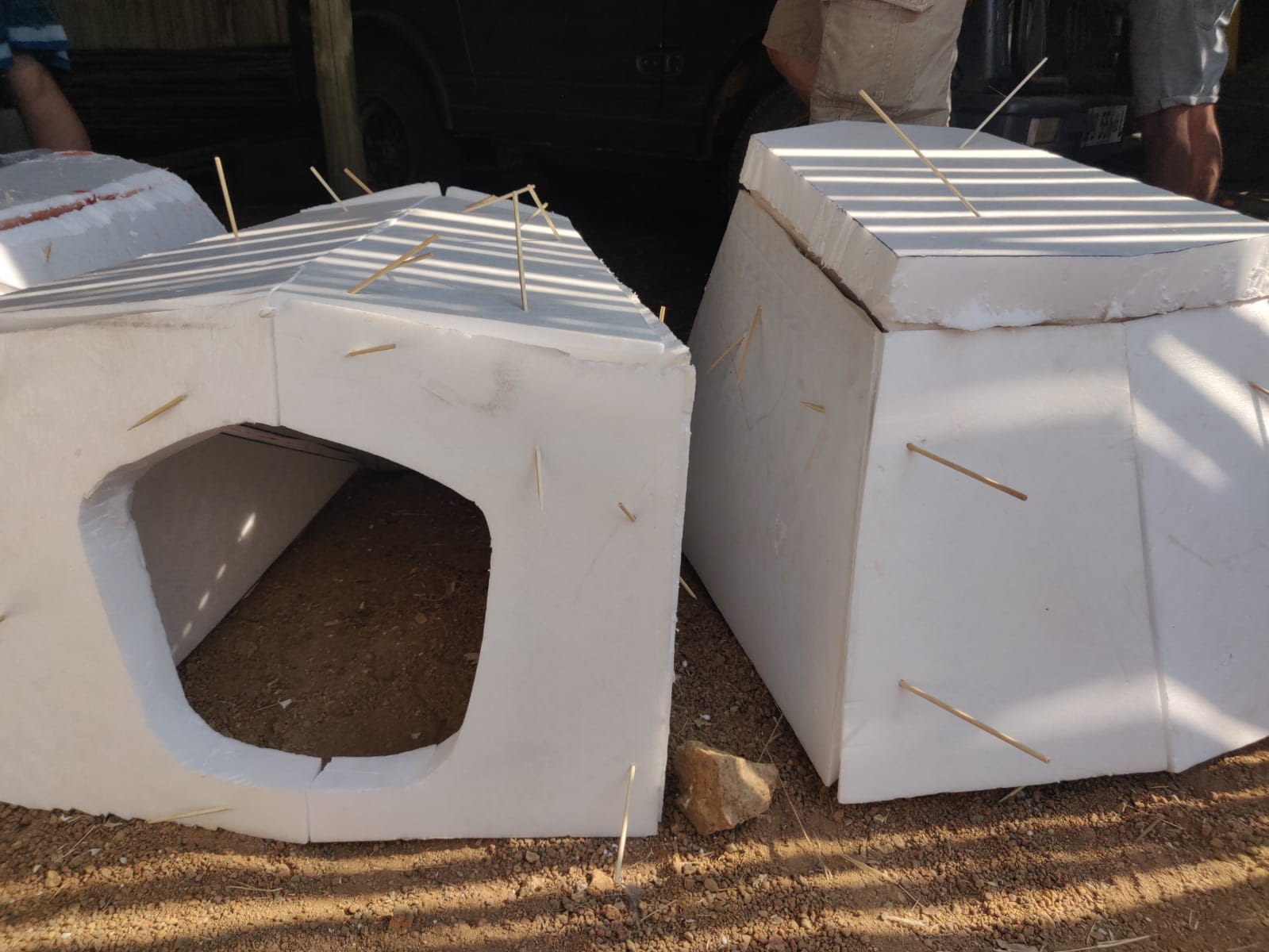
We were very fortunate to get some of Kyle’s students volunteering their time to help us build nests. It was hard work, and they did a great job. All in all, we built 10 nests in September, and quickly sent them to the APNR for installation before the breeding season began.
Our nest design continues to undergo refinement. The former round of nests was sturdy, but we discovered that adding sand into the resin mix to give it texture and protection was actually adding a significant amount of weight, and trapped more heat. Kyle Brand went to the drawing board once again and developed a smaller, more manageable nest made of foam polygons fit together like a puzzle, more fabric layers, and no sand. The final product is strong, much lighter, and the birds love it! This year the APNR had a number of these nests mounted in trees, and the ground-hornbills took to them right away.
As always, we’ll continue gather data on their effectiveness and improve our design.
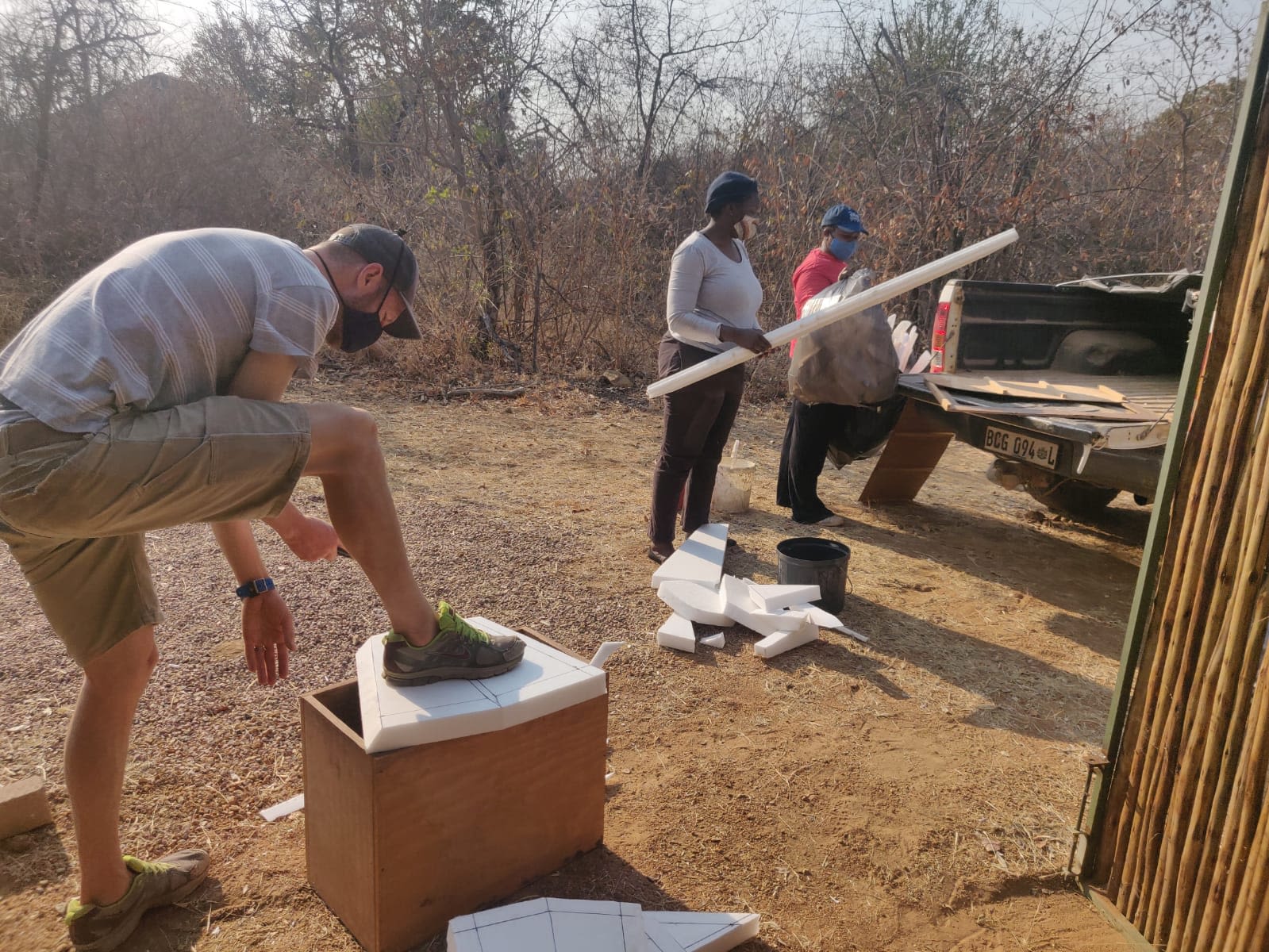
The legendary Kyle Brand on the new super-light version of the nest so that the final nest weighs just 30kg.
The legendary Kyle Brand on the new super-light version of the nest so that the final nest weighs just 30kg.
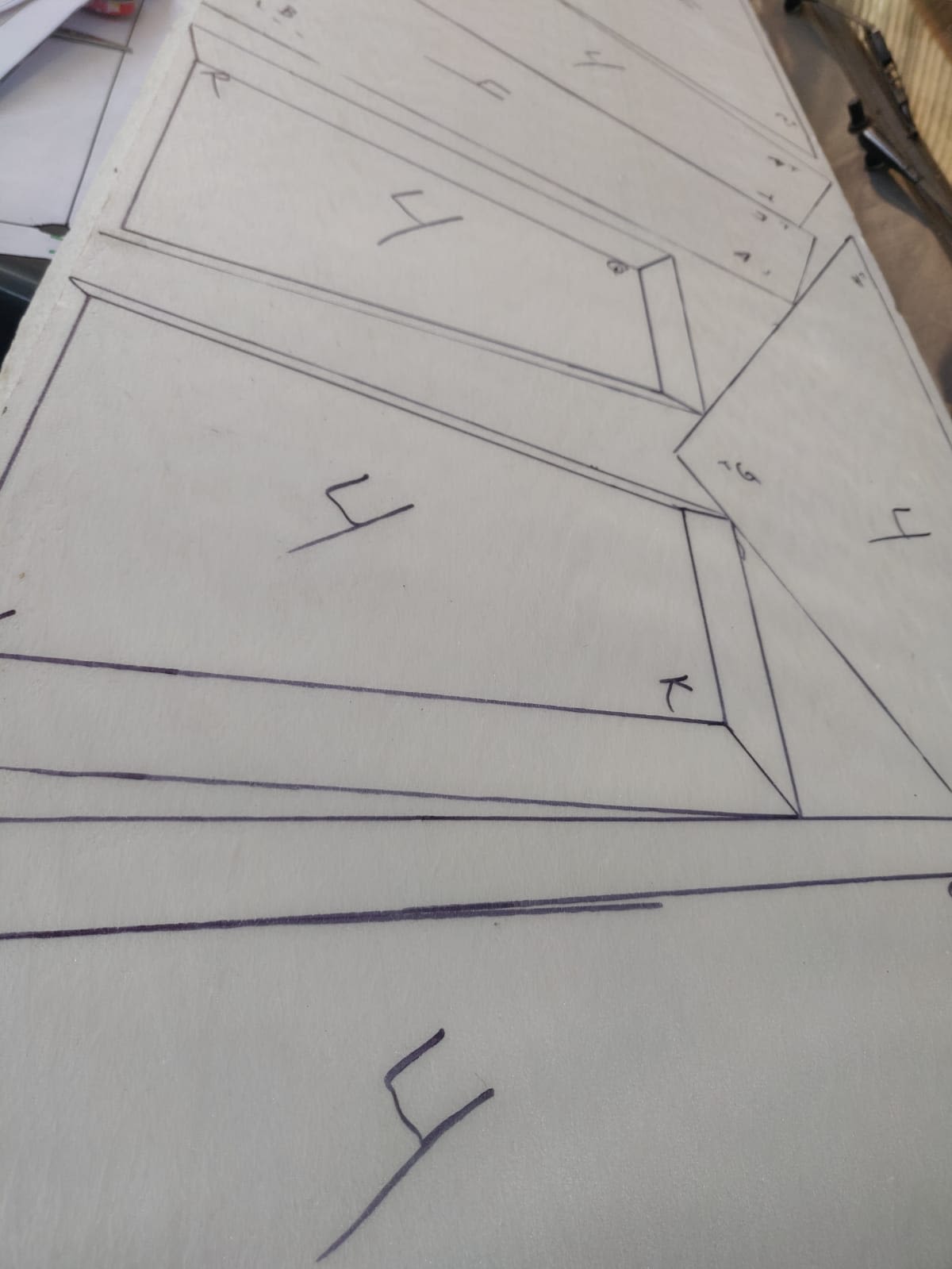
The first batch had to be done the old fashioned way but the new batch is cut by the robotic arm at the Tshwane Univ. of Technology, and so we will be able to work much more effectively (and with way less sweat and tears).
The first batch had to be done the old fashioned way but the new batch is cut by the robotic arm at the Tshwane Univ. of Technology, and so we will be able to work much more effectively (and with way less sweat and tears).
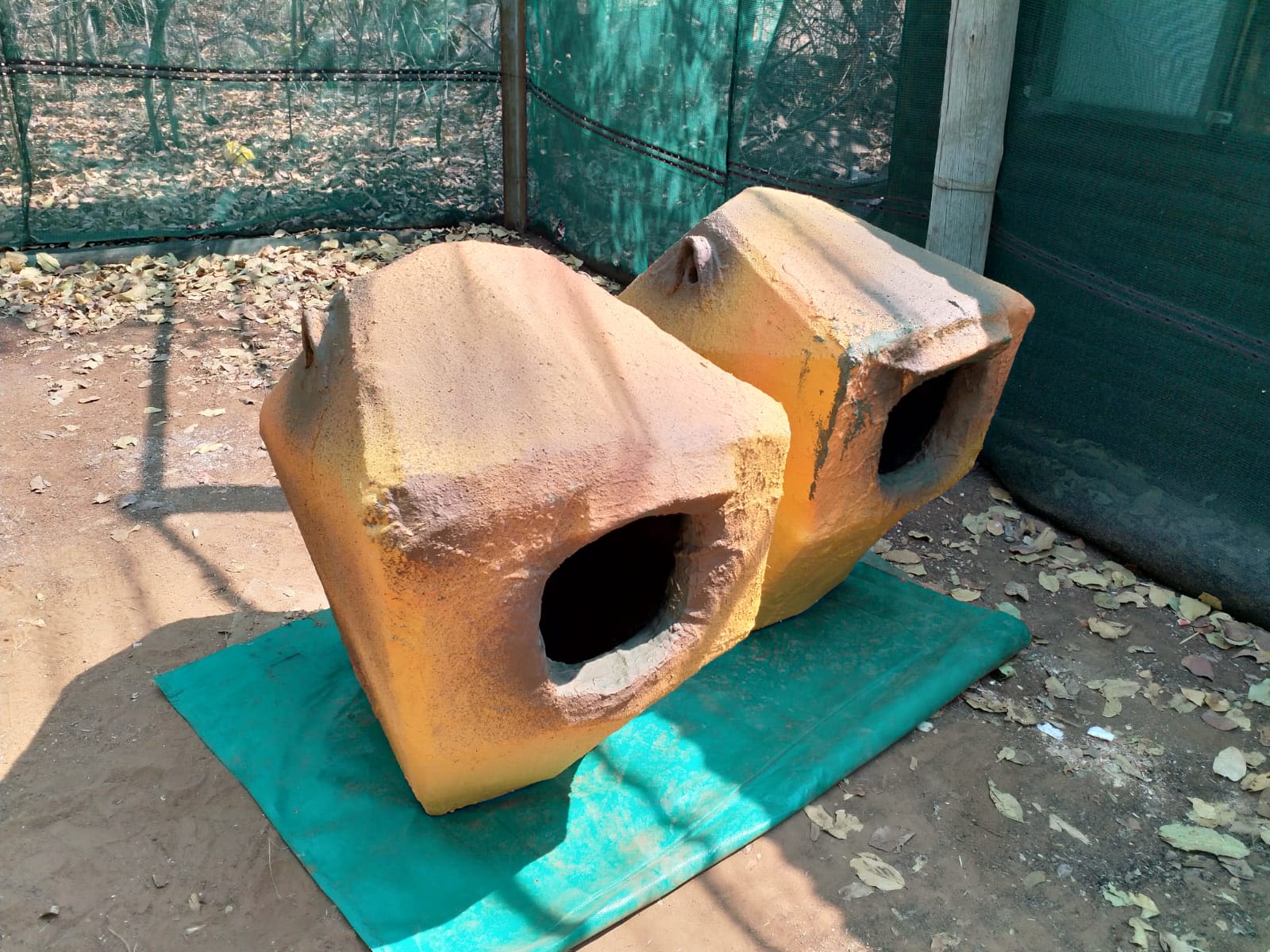
Much tougher and lighter than the previous models - so here is to many safe hatches this coming season.
Much tougher and lighter than the previous models - so here is to many safe hatches this coming season.
Intern and Student Intro
Elizabeth Zadnik
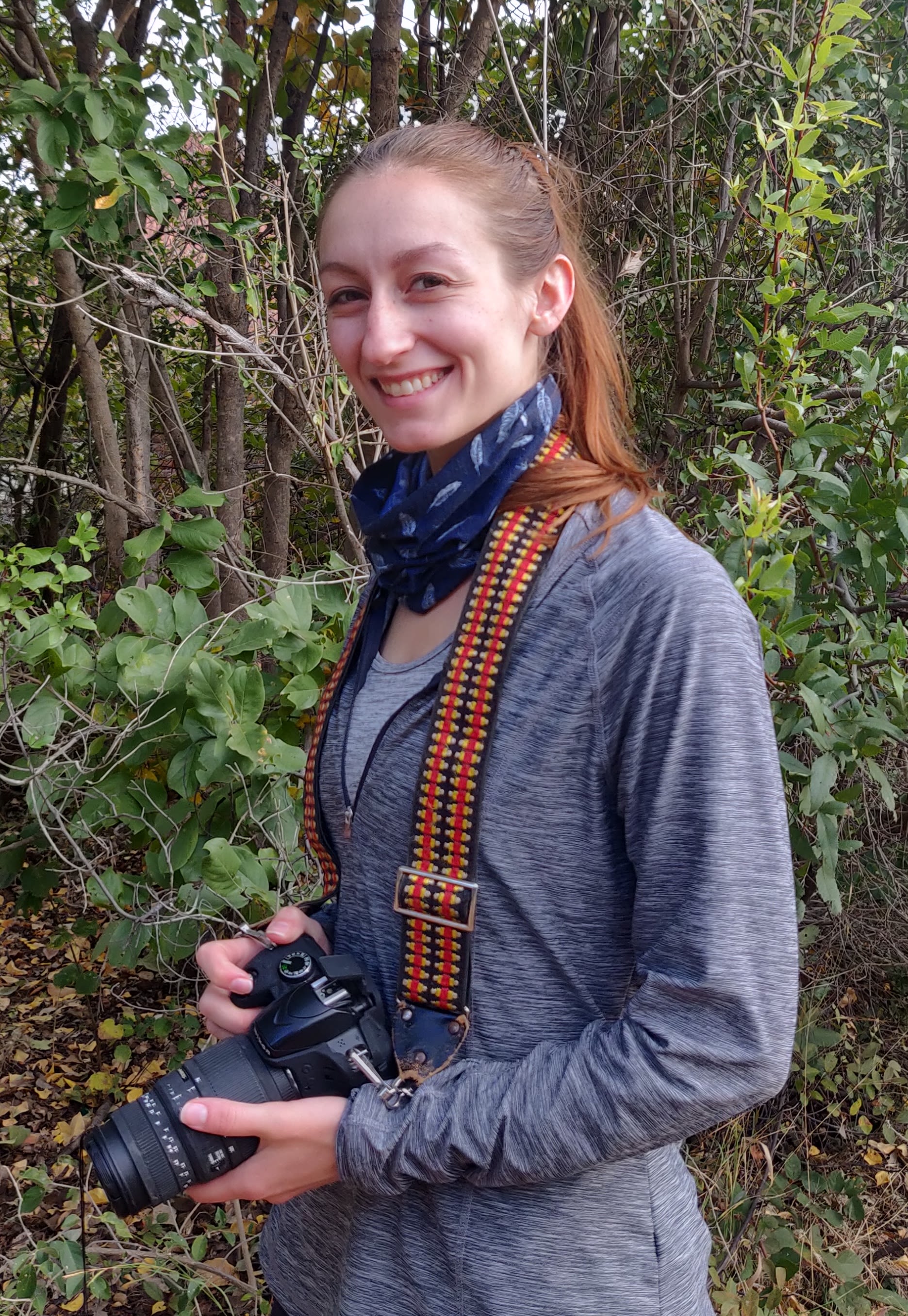
I've been interested in ecology for a long time, and earned a Bachelor's degree in Biology at Virginia Polytechnic Institute and State University in the US. After graduating I worked and volunteered at a raptor centre, and subsequently held a full-time raptor care position in a zoo. There I helped train a young Southern Ground-hornbill, and a fascination with the species led me to further research and contact with the MGHP once the pandemic started. The MGHP is an amazing example of species restoration rooted in effective science and community involvement. I'm excited and honoured to learn more about these amazing birds and to contribute to their preservation.
I've been interested in ecology for a long time, and earned a Bachelor's degree in Biology at Virginia Polytechnic Institute and State University in the US. After graduating I worked and volunteered at a raptor centre, and subsequently held a full-time raptor care position in a zoo. There I helped train a young Southern Ground-hornbill, and a fascination with the species led me to further research and contact with the MGHP once the pandemic started. The MGHP is an amazing example of species restoration rooted in effective science and community involvement. I'm excited and honoured to learn more about these amazing birds and to contribute to their preservation.
Fisokuhle Ngwenya
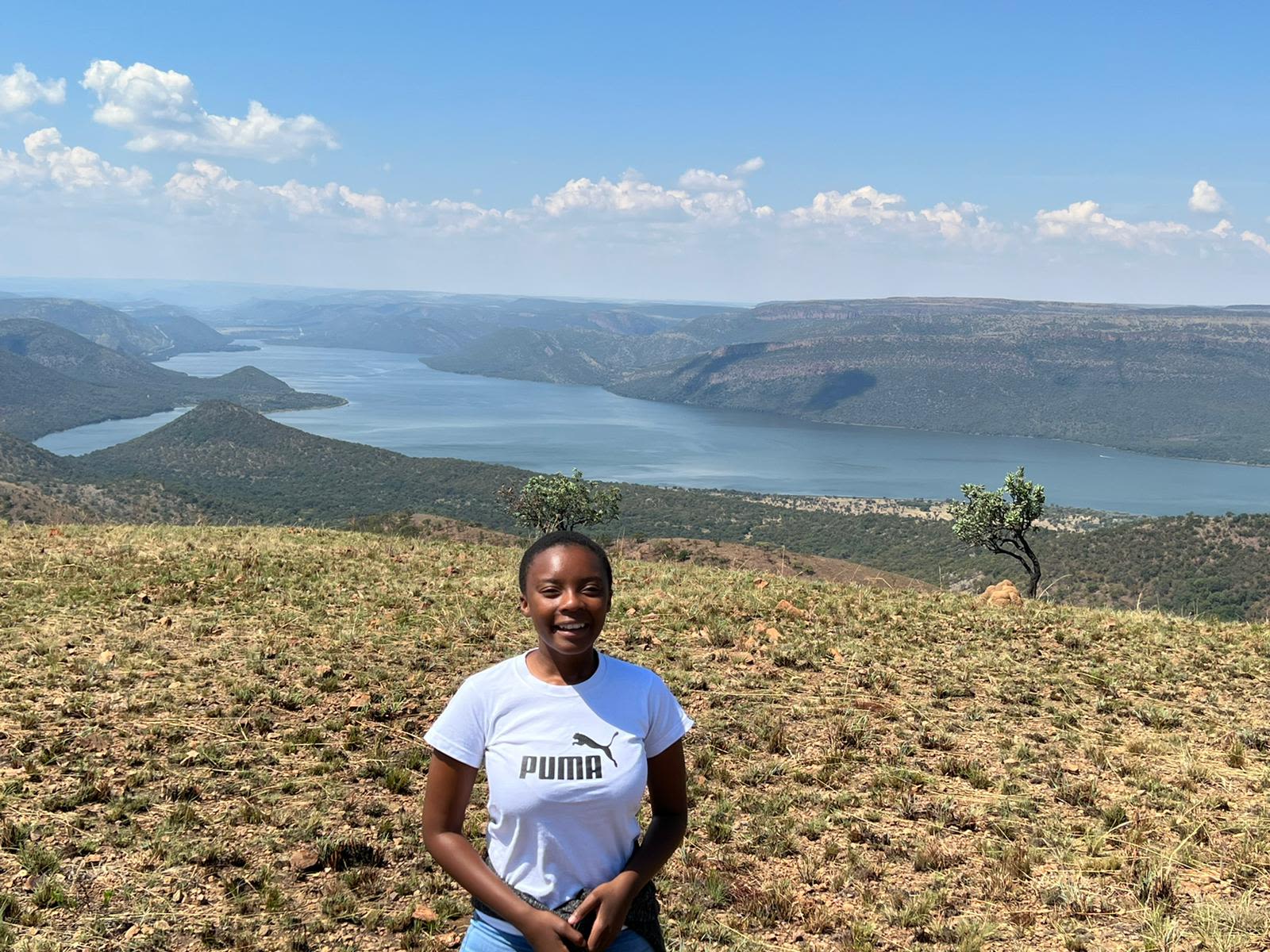
I am a nature conservation student doing my practical year with the MGHP team. First time hearing about Conservation I thought it was for snobs but my first class which was environmental management sealed my love for nature and that’s when I knew this is what I want to do more than anything, and also my love for animals kept me going, one of my goals is to study more about Zoology. Working for the project is one fun roller-coaster because the experiences differ each and every day, a new activity the birds do sometimes might be sad but most of the time it is educational.
I am a nature conservation student doing my practical year with the MGHP team. First time hearing about Conservation I thought it was for snobs but my first class which was environmental management sealed my love for nature and that’s when I knew this is what I want to do more than anything, and also my love for animals kept me going, one of my goals is to study more about Zoology. Working for the project is one fun roller-coaster because the experiences differ each and every day, a new activity the birds do sometimes might be sad but most of the time it is educational.
Our last student placements, Nomcebo Mathebula and Celukuthula Msweli, were with the team until early 2022. They helped out both at the main Mabula office and at the Baobab, and contributed a lot to our nest building efforts and educational Hornbill Drives. Nomcebo was a vital part of the March Populations and Perceptions field work, and Celukuthula stayed on an extra week in February to teach Fisokuhle the ropes.
Fisokuhle Ngwenya joined the MGHP team in February 2022, to complete her practical year for her studies. She has been working with Natasha and Hein at the Baobab rearing facility. It’s a great help to have her around, there’s a lot of work to be done in raising this year’s chicks!
Elizabeth Zadnik joined the team last June, and is working on renewing her visa so she can stay with the Project longer.
We have also recently partnered with ROOTS, an organization matching volunteers with nonprofit internships in Africa. We were very excited to welcome our first ROOTS intern, Natalie Molea, in June.
Natalie Molea joined the team from the USA in May 2022 for some much-needed practical experience for her Master’s work. She was an enthusiastic team member who took part in activities such as SGH monitoring, write-up and research as well as SGH husbandry and care. This was her first experience in the African bush, and we are proud to have given her an opportunity to learn more about conservation from an African perspective.
Kruger Field Work
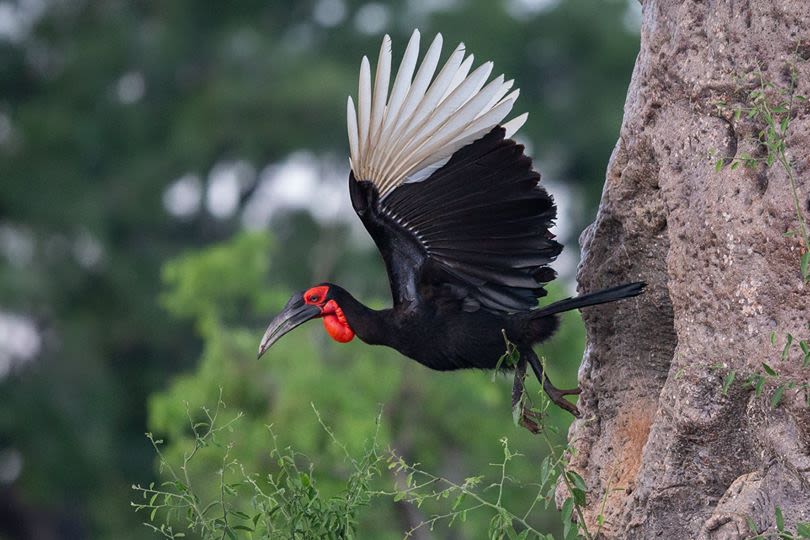
A Low Productivity Year
We conducted field work in November and March to check the productivity of the wild population in Kruger: November to see which nests have eggs, and March to check the survival of the juveniles. We checked all our usual nests as well as some historic ones found in the data of Dr Alan Kemp, and investigated some citizen science reports of ground-hornbill nesting sightings, over 20 new nests in all.
Many nests that we recorded as active in the past showed no sign of activity this year. It may have been poor timing for the nest check field trips, but assessing such a wide range will inevitably come with schedule difficulties: the weather patterns are not uniform throughout Kruger, different groups throughout the Park will breed at different times.
In November: Of the 87 nests, seven contained eggs (14 eggs in total), 19 were active/lined, 26 were not lined, and 15 had collapsed (either the entire tree or the cavity; however, many of these nests were old nests originally assessed by Alan Kemp between 1960 and 1990) and the rest were inaccessible due to height or terrain.
In March: Of 64 nests assessed, there were 7 checks, two unseen citizen science reported chicks, 23 were not active, one had collapsed, and one nest was predated by a leopard. There were a number of nests found empty that were marked Active from November, so it's possible that either the breeding was unsuccessful or a chick fledged early.
This year we had irregular weather patterns- late rains in November, erratic torrents in February and March - that we believe had a negative impact on the breeding. Southern ground-hornbills are choosy breeders, and it’s possible for them to breed yearly, but more common to skip a few years in between rearing juveniles. Though this year was not a very productive one for the Kruger wild population, we are optimistic about next year.
On the positive side, we were very happy to discover some new never-before-recorded nests during our trip! We have also added a telescoping pole to the field equipment, which enables us to raise a camera up to previously inaccessible nests. This has been a huge help in the March checks, and will dramatically increase the number of nests we’re able to investigate. We have also started taking 3D scans of the interior of the nests, with the assistance of Kyle Brand. It’s a big step in making our artificial nests as accurate as possible to the ground-hornbills’ nesting preferences.
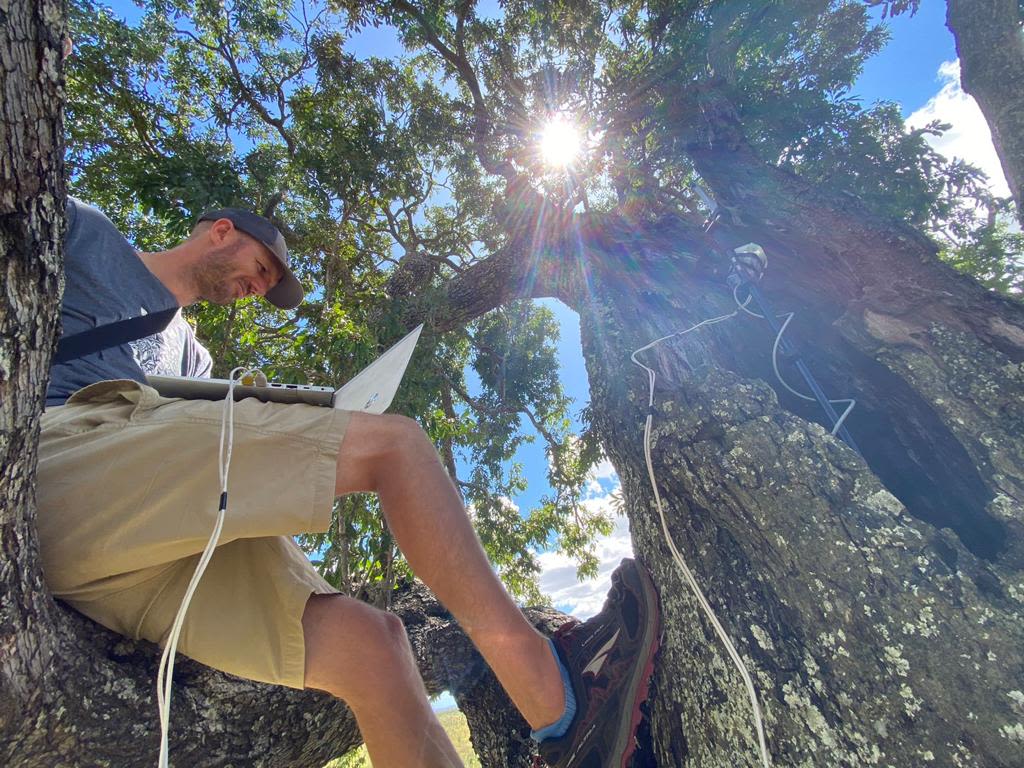
Kyle Brand scales the trees with a rope harness and all his equipment. Not many people are brave enough to bring a laptop into a tree like this, but Kyle is an expert!
Kyle Brand scales the trees with a rope harness and all his equipment. Not many people are brave enough to bring a laptop into a tree like this, but Kyle is an expert!
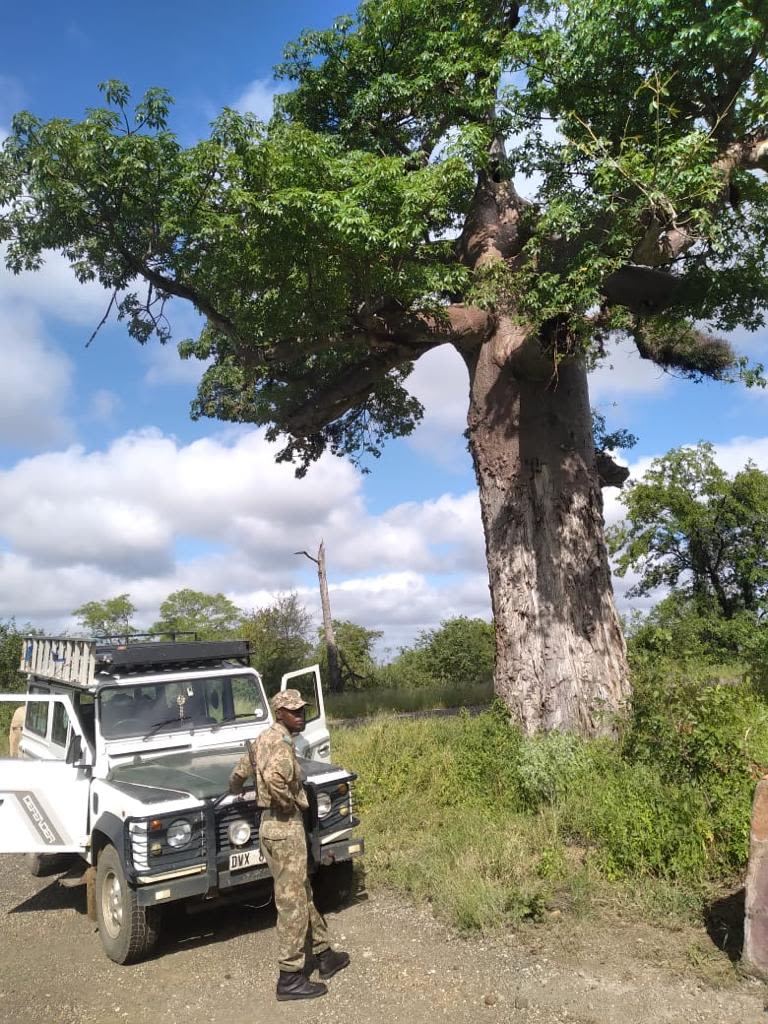
Sometimes as we’re driving we catch sight of a ground-hornbill with nesting materials or flying into a nest. Such a lucky catch! Here’s a photo of one of these new nests, and game guard David
Sometimes as we’re driving we catch sight of a ground-hornbill with nesting materials or flying into a nest. Such a lucky catch! Here’s a photo of one of these new nests, and game guard David
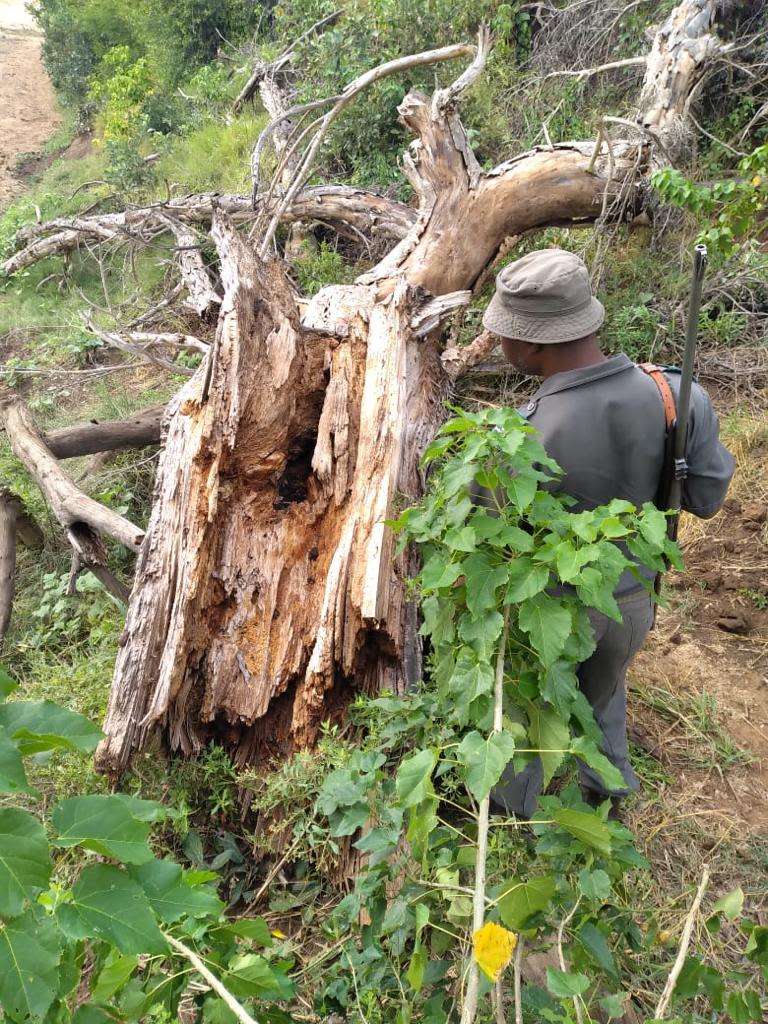
Fallen Nest: As Southern ground-hornbills are cavity nesters, they choose nesting trees with large holes. Unfortunately this comes with the possible condition of a dead or rotting tree. Occasionally when we visit one of the nests, we find this instead. Game guard Hermann Ntimane is assisting with the examination here.
Fallen Nest: As Southern ground-hornbills are cavity nesters, they choose nesting trees with large holes. Unfortunately this comes with the possible condition of a dead or rotting tree. Occasionally when we visit one of the nests, we find this instead. Game guard Hermann Ntimane is assisting with the examination here.
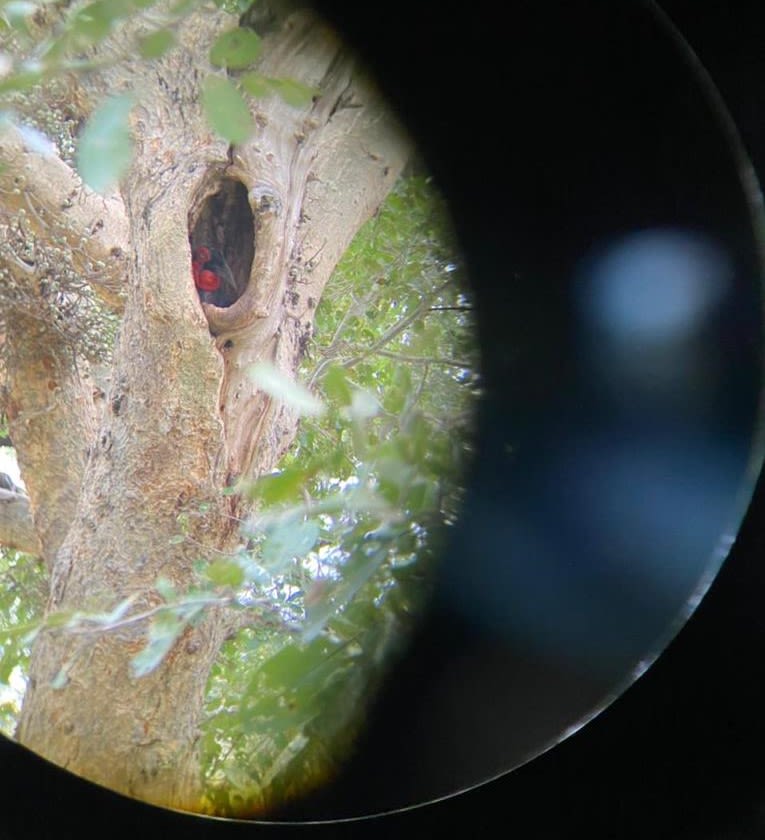
Binocular view of this female minding her chick
Binocular view of this female minding her chick
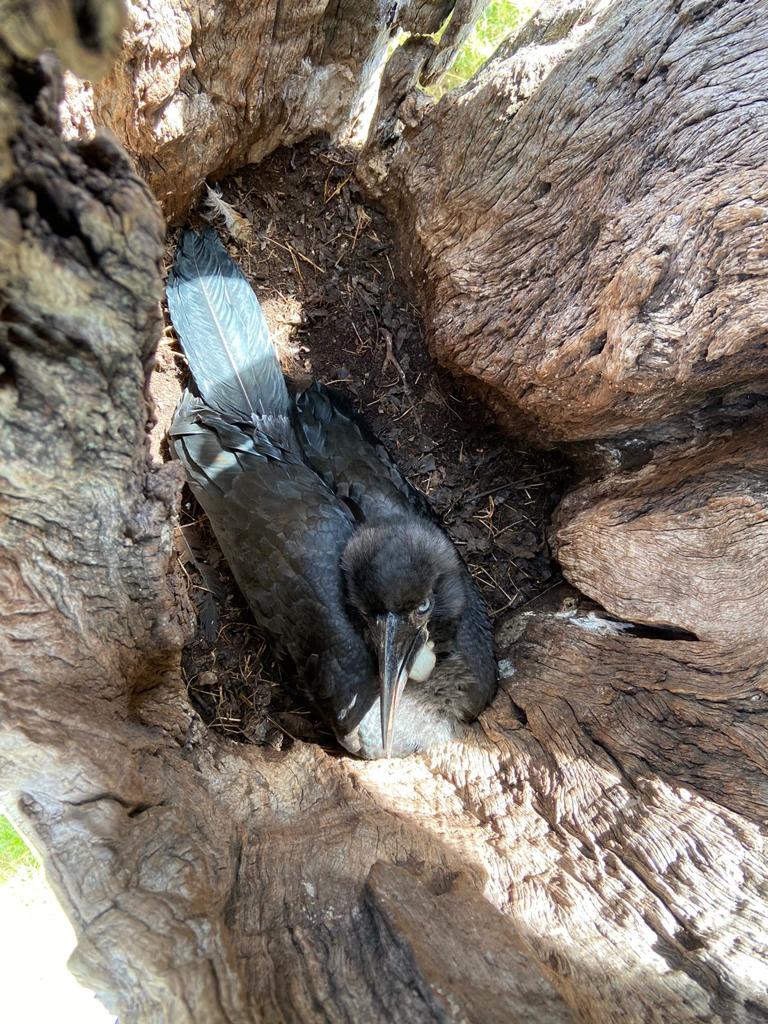
This Toulon chick is fledging beautifully
This Toulon chick is fledging beautifully
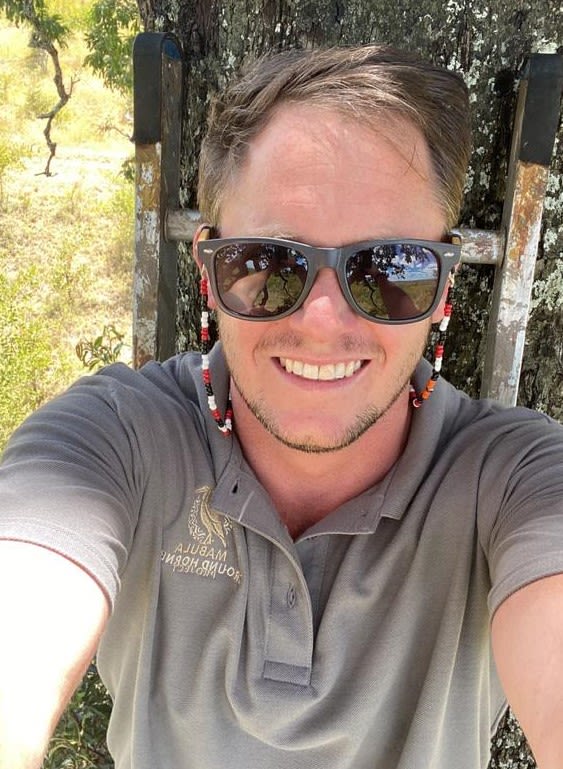
Dr Jarryd Alexander sporting the black, white, and orange MGHP glasses straps
Dr Jarryd Alexander sporting the black, white, and orange MGHP glasses straps
Lowveld Expansion Project
Patience Shito's MSc work continues
Last Newsletter we announced that Patience Shito was starting her MSc work on assessing the Lowveld region for expansion feasibility. Her work has progressed significantly in the past months. The assessment involves gathering data for possible threats to nesting trees like the Marula and Baobab, distributing educational materials, inquiring after any ground-hornbill sightings in the areas, and conducting Population and Perception surveys.
Population and Perception Surveys
The Lowveld area outside of Kruger is home to many communities, and with diversity in culture comes differences in how the Southern ground-hornbill may be valued. We have to understand the perceptions of the bird within these communities before we can best assess how to approach bespoke conversation action.
Patience has now organized several field trips to conduct interviews across the entire area, and led widespread educational outreach to thousands of people at Guyuni, Tshamavhudzi, Sanari-Mutale and Makgari, Ga-mama, Maleboho, Phalubeni, Mbaula, Welverdiende and Timbavati. She’s collected hundreds of interviews, found a possible new groups through sightings reports, even found some new cultural perceptions of which the MGHP team had not been previously aware.
"At Maatlaba’s village, a young man in his early 30s remembered seeing two SGHs usually after the rains in his village which is halfway to Lephalale from Thabazimbi in the ’90s. . . Another Tshivenda-speaking man from Thengwe village is used to seeing them walk around the village. He last saw them two years ago. . . A Zimbabwean lady from Masvingo knows the birds from home, only seeing them before or after the rains."
As part of the outreach efforts alongside the interviews,1000+ SGH pamphlets have been distributed, 500+ school learners and educators attended SGH lessons, and 250 posters were put up in a variety of locations.
“ SGH are bringers of peace. Their presence in an area shows that there will be peace in the land”
“The love that exists between individuals in an SGH group gave rise to their local Xitsonga name Rhandzane”
We’re very excited that Patience is making so much progress, and are looking forward to her conclusions.
This Year's Harvest
This year was the first use of the Baobab's internal rearing room, built for easy access and monitoring
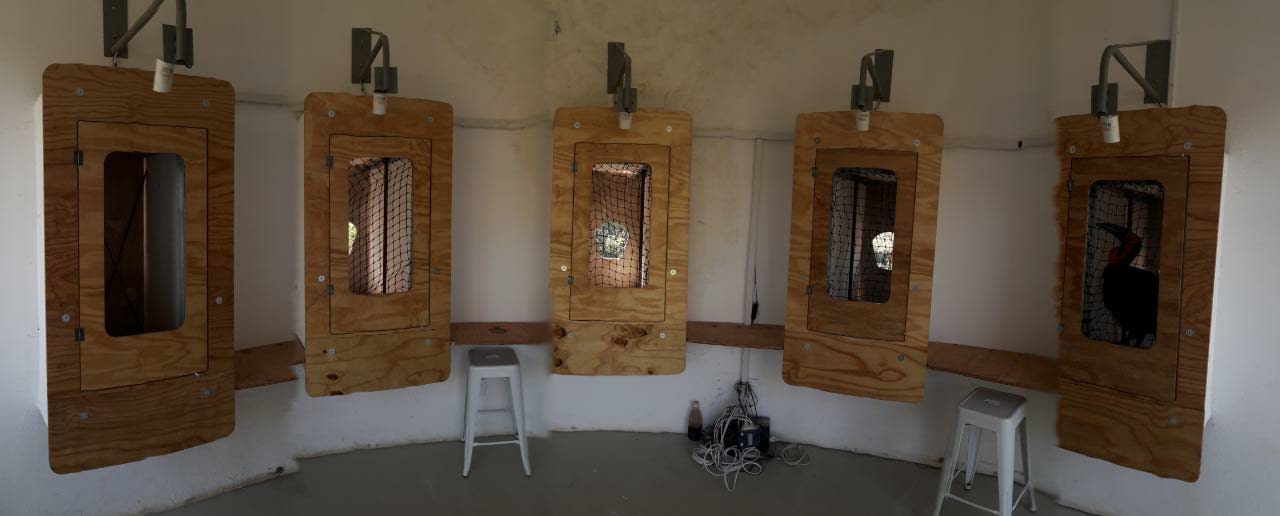
This year the APNR recorded less breeding than usual, just like our findings in Kruger. The Baobab still ended up with four second-laid chicks. Each hatched about two weeks apart, which makes a challenge for Natasha Nel, as the different stages of development all needed different amounts of food and care. Some chicks had a more difficult time than others, but they’ve all been developing well.
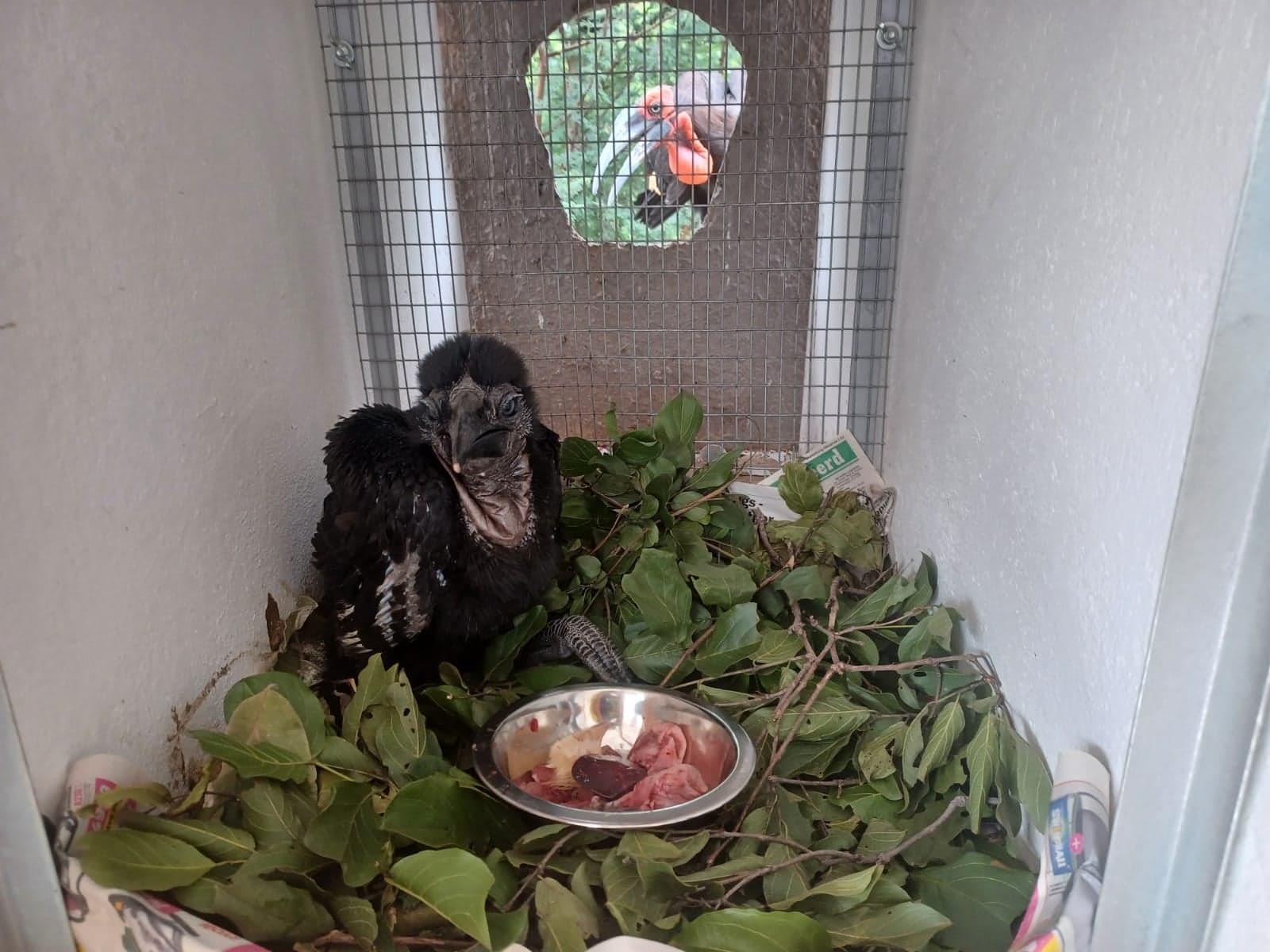
Our socialization setup: The chick is placed in the “nest” where it can hear and see the adult, and is monitored remotely with a camera. The adult can come inside the nest from the opposite side, and a mesh protects the chick.
Our socialization setup: The chick is placed in the “nest” where it can hear and see the adult, and is monitored remotely with a camera. The adult can come inside the nest from the opposite side, and a mesh protects the chick.
Dr John Kani & Dr Gcina Mphlophe
lend us their voices
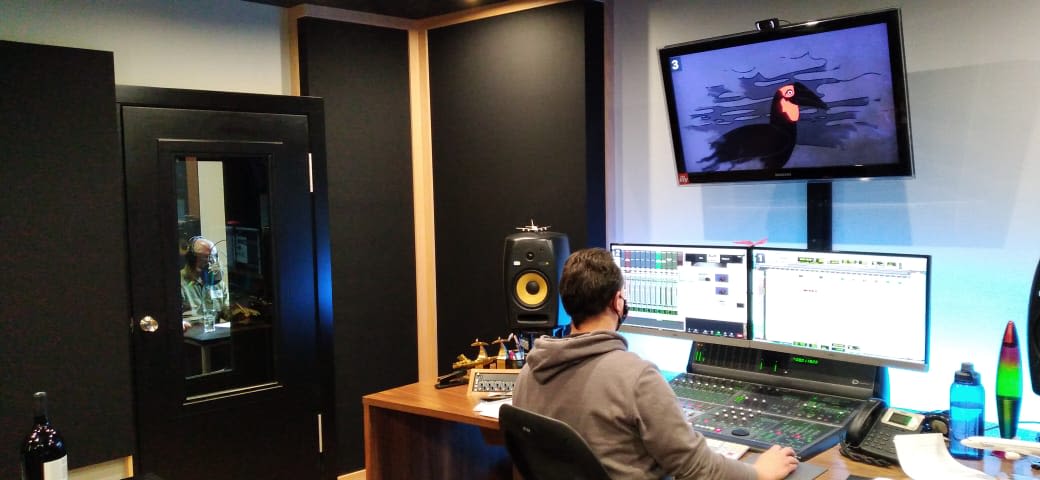
Both Dr John Kani (for English and isisXhosa) and Dr Gcina Mhlophe (isiZulu) have done incredible voice-overs for our conservation animation. With support from Tincup Animation, Triggerfish Animation, Sonic Studios (Durban) and Sonovision (Gauteng). Can't wait to see the final product.
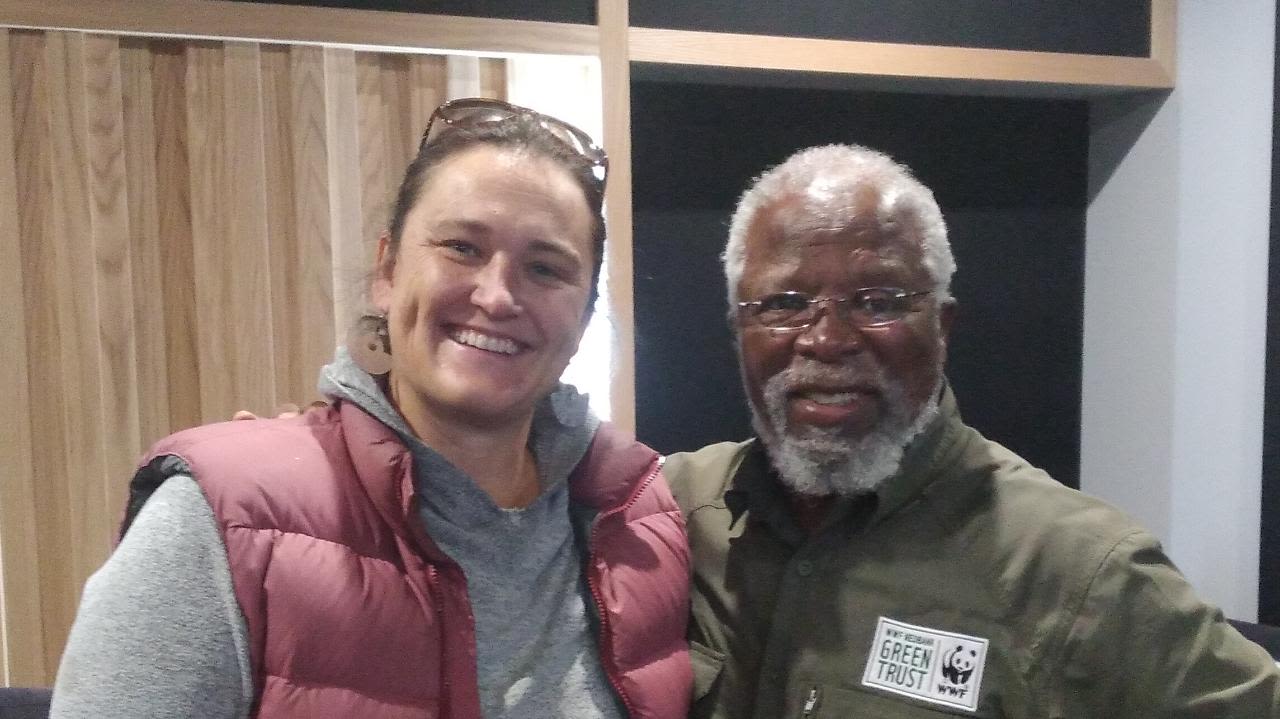
A very smug-looking Lucy got to hang with Dr Kani for a morning at the recording studio. It was an incredible experience.
A very smug-looking Lucy got to hang with Dr Kani for a morning at the recording studio. It was an incredible experience.
The National Monitoring Plan is soaring
We now have 66 Champion-led groups!
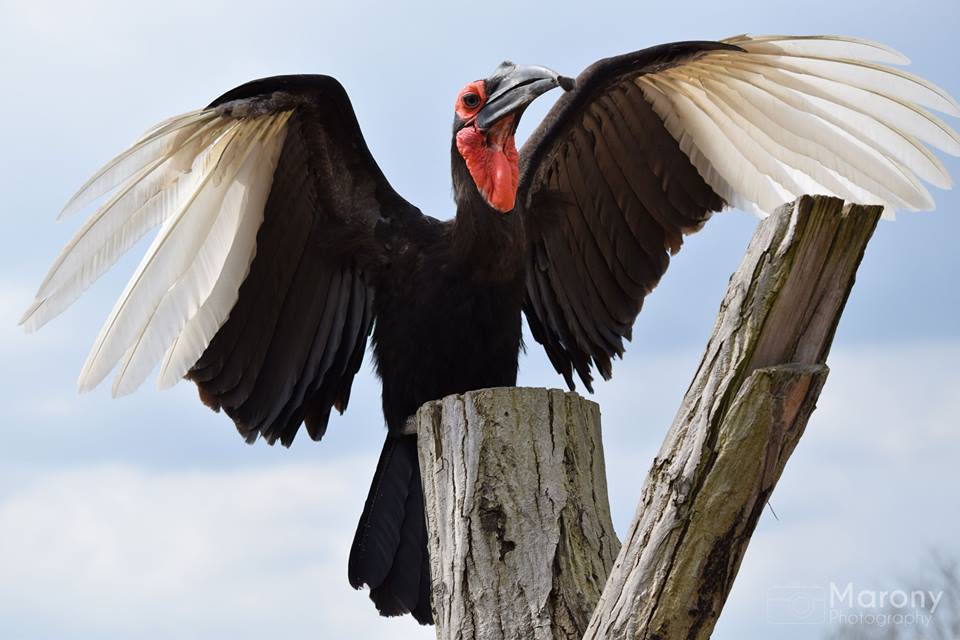
There are now over 1,000 people sending us sightings through the Champions groups, with 400 to 900 sightings every month. Repeat sightings are vital to monitoring the wild populations. A huge THANK YOU to our Champions for making this groundbreaking monitoring strategy possible!
If you live in the Southern ground-hornbill range and aren’t part of our Champions groups yet, consider joining the team!
Message our sightings number 079 754 6234 on Whatsapp, and you’ll be able to join a local group or establish a Whatsapp group of your own with others in the area. When people report their sightings in the group it helps the accuracy of our distribution maps, and you can be a hornbill hero just by keeping an eye out. If you get any photos, send them in! We love to post our Champions’ sightings on social media.
BirdLife South Africa
OWL AWARDS
Every year BirdLife South Africa hosts the Owl Awards to recognize people and organizations making strides in avian conservation. This past year they hosted their awards ceremony over Zoom.
The MGHP was awarded the Eagle Owl Award. Thanks to BirdLife SA for the recognition!
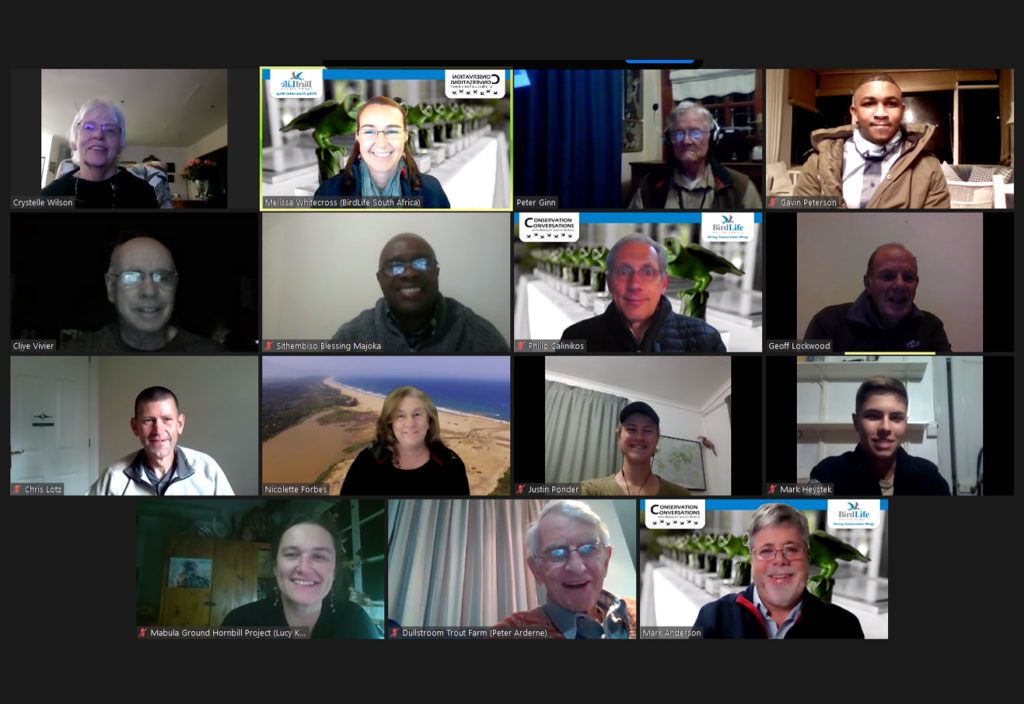
Find Us Out There:
“Just rewards - Global recognition for Mabula Group Hornbill Project” by Dr Lucy Kemp
“In search of the Thunderbird” by Dr Jarryd Alexander
“Talk with Nthabiseng Monama” by Lebogang Ngobeni
This publication was produced with the financial support of the European Union through IUCN Save Our Species. Its contents are the sole responsibility of and do not necessarily reflect the views of IUCN or the European Union.
We would like to continue to send you our news and updates on matters regarding conservation, wildlife management and research, but we respect your privacy. So now is the time to indicate if you wish to be removed from our mailing lists by simply responding to this email with “unsubscribe” in the subject line. Thereafter we will remove you from our mailing list and you will no longer receive any further correspondence from us.
To remain on our mailing lists you don’t need to respond.
We respect your privacy - should you wish to no longer receive these emails, please click the "unsubscribe" link below. Thereafter you will no longer receive any correspondence from us.
We would also like to take this opportunity to assure you that your personal information (email and name) is controlled and securely stored. If you wish to continue receiving our updates, you needn't click anything. We also would like to assure you that we will not share your information with third parties without your consent or use your details irresponsibly.

